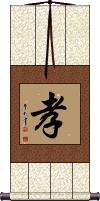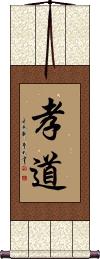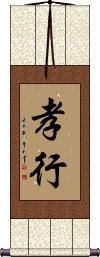Many custom options...
And formats...

Filial Piety in Chinese / Japanese...
Buy a Filial Piety calligraphy wall scroll here!
Personalize your custom “Filial Piety” project by clicking the button next to your favorite “Filial Piety” title below...
Filial Piety
孝 represents filial piety.
Some will define this in more common English as “respect for your parents and ancestors.”
孝 is a subject deeply emphasized by the ancient philosophy and teachings of Confucius.
Some have included this in the list for the Bushido, although generally not considered part of the 7 core virtues of the warrior.
Note: 孝 is not the best of meanings when seen as a single character. Some will read the single-character form to mean “missing my dead ancestors.” However, when written as part of Confucian tenets, or in the two-character word that means filial piety, the meaning is better or read differently (context is important for this character).
We suggest one of our other two-character filial piety entries instead of this one.
The Dao of Filial Piety
孝道 most clearly expresses the Confucian philosophy of filial piety.
Confucius taught that all should be respectful and obedient to their parents. Included in this idea is honoring your ancestors.
The second character is “dao/tao” or “the way” as in Taoism. You can say this title is “The Tao of Filial Piety” or “The Way of Filial Piety.”
See Also: Confucius
Filial Piety / Filial Conduct
孝行 expresses the idea of filial piety or filial conduct.
While the first character means filial piety by itself, the second character adds “action.” Therefore this represents the actions you take to show your respect and obedience to your elders or ancestors.
Confucius is probably the first great advocate for filial piety.
Honor for Ancestors
祖先崇拜 means “Appreciation and honor of your ancestors.”
This can refer to anyone from your grandparents and beyond.
The first two characters mean ancestors or forefathers.
The last two characters mean worship, adore/adoration, or admiration.
This is the kind of wall scroll that a filial son or daughter in China or Japan would hang to honor their ancestors who paved the way for the new generation.
![]() Japanese use a slight variation on the last Kanji. If you want this specifically Japanese version, just click on the Kanji image to the right (instead of the button above). Note that Japanese people would easily be able to identify the original Chinese form of that Kanji anyway.
Japanese use a slight variation on the last Kanji. If you want this specifically Japanese version, just click on the Kanji image to the right (instead of the button above). Note that Japanese people would easily be able to identify the original Chinese form of that Kanji anyway.
They also have a similar phrase in old Korean but the first two characters are reversed - just let me know if you want that version when you place your order.
Not the results for filial piety that you were looking for?
Below are some entries from our dictionary that may match your filial piety search...
| Characters If shown, 2nd row is Simp. Chinese |
Pronunciation Romanization |
Simple Dictionary Definition |
孝 see styles |
xiào xiao4 hsiao kou; kyou(ok) / ko; kyo(ok) こう; きょう(ok) |
More info & calligraphy: Filial Piety(See 孝行・1) filial piety; (given name) Yasuaki Filial, obedient. |
孝行 see styles |
koukou / koko こうこう |
More info & calligraphy: Filial Piety / Filial Conduct |
孝道 see styles |
xiào dao xiao4 dao5 hsiao tao koudou / kodo こうどう |
More info & calligraphy: The Dao of Filial Pietyfilial piety; (given name) Takamichi |
三福 see styles |
sān fú san1 fu2 san fu mifuku みふく |
(place-name, surname) Mifuku The three (sources of) felicity: (1) The 無量壽經 has the felicity of (a) 世福 filial piety, regard for elders, keeping the ten commandments; (b) 戒福 of keeping the other commandments; (c) 行福 of resolve on complete bodhi and the pursuit of the Buddha-way. (2) The 倶舍論 18, has the blessedness of (a) 施類福 almsgiving, in evoking resultant wealth; (b) 戒類福 observance of the 性戒 (against killing, stealing, adultery, lying) and the 遮戒 (against alcohol, etc.), in obtaining a happy lot in the heavens; (c) 修類福 observance of meditation in obtaining final escape from the mortal round. Cf. 三種淨業. |
不孝 see styles |
bù xiào bu4 xiao4 pu hsiao fukou(p); fukyou / fuko(p); fukyo ふこう(P); ふきょう |
unfilial (noun or adjectival noun) (1) undutifulness to one's parents; lack of filial piety; (noun or adjectival noun) (2) (ふきょう only) (archaism) (See 八虐) (the crime of) cursing one's parents; (noun or adjectival noun) (3) (ふきょう only) (archaism) disowning one's child unfilial |
両全 see styles |
ryouzen / ryozen りょうぜん |
(1) completeness in both (e.g. loyalty and filial piety, study and sports); (can be adjective with の) (2) advantageous to both sides |
五倫 五伦 see styles |
wǔ lún wu3 lun2 wu lun gorin ごりん |
the five Confucian relationships (ruler-subject, father-son, brother-brother, husband-wife, friend-friend) the five Confucian filial-piety relationships |
反哺 see styles |
fǎn bǔ fan3 bu3 fan pu hanpo はんぽ |
to support one's parents in their old age; to show filial piety; to to repay; to return a favor caring for one's parents in return; (given name) Hanpo |
喪棒 丧棒 see styles |
sāng bàng sang1 bang4 sang pang |
funeral stick (held by the son as a sign of filial piety) |
嘗糞 尝粪 see styles |
cháng fèn chang2 fen4 ch`ang fen chang fen shoufun / shofun しょうふん |
to taste a patient's excrement (a form of medical examination, seen as an act of loyalty or filial piety); to suck up to sb; to kiss ass shamelessly flattering; brown-nosing; licking excrement |
孝弟 see styles |
takayasu たかやす |
filial piety; brotherly love; (given name) Takayasu |
孝心 see styles |
xiào xīn xiao4 xin1 hsiao hsin koushin / koshin こうしん |
filial piety (a Confucian obligation); respect and obedience to one's parents filial devotion; (personal name) Kōshin |
孝悌 see styles |
xiào tì xiao4 ti4 hsiao t`i hsiao ti takayoshi たかよし |
filial piety and fraternal duty filial piety; brotherly love; (male given name) Takayoshi |
孝敬 see styles |
xiào jìng xiao4 jing4 hsiao ching koukei / koke こうけい |
to show filial respect; to give presents (to one's elders or superiors); to support one's aged parents filial piety; (male given name) Takayoshi |
孝経 see styles |
koukyou / kokyo こうきょう |
the Book of Filial Piety |
孝經 孝经 see styles |
xiào jīng xiao4 jing1 hsiao ching |
Xiaojing (Classic of Filial Piety) |
孝順 孝顺 see styles |
xiào shùn xiao4 shun4 hsiao shun koujun / kojun こうじゅん |
filial; dutiful; devoted to one's parents (and grandparents etc); to show filial piety towards (an older family member); filial piety (noun or adjectival noun) obedience; filial piety; (personal name) Takayori Obedient. |
忠孝 see styles |
zhōng xiào zhong1 xiao4 chung hsiao chuukou / chuko ちゅうこう |
loyalty and filial piety; (given name) Chuukou loyalty and filial piety |
愚孝 see styles |
yú xiào yu2 xiao4 yü hsiao |
unquestioning filial piety |
至孝 see styles |
shikou; shiikou / shiko; shiko しこう; しいこう |
supreme filial piety; (given name) Yoshitaka |
跪乳 see styles |
guì rǔ gui4 ru3 kuei ju |
(literary) (of a lamb) to kneel to suckle at the breast (used as a metaphor for filial piety) |
十三經 十三经 see styles |
shí sān jīng shi2 san1 jing1 shih san ching |
the Thirteen Confucian Classics, namely: Book of Songs 詩經|诗经[Shi1 jing1], Book of History 尚書|尚书[Shang4 shu1], Rites of Zhou 周禮|周礼[Zhou1 li3], Rites and Ceremonies 儀禮|仪礼[Yi2 li3], Classic of Rites 禮記|礼记[Li3 ji4], Book of Changes 易經|易经[Yi4 jing1], Mr Zuo's Annals 左傳|左传[Zuo3 Zhuan4], Mr Gongyang's Annals 公羊傳|公羊传[Gong1 yang2 Zhuan4], Mr Guliang's Annals 穀梁傳|谷梁传[Gu3 liang2 Zhuan4], The Analects 論語|论语[Lun2 yu3], Erya 爾雅|尔雅[Er3 ya3], Classic of Filial Piety 孝經|孝经[Xiao4 jing1], Mencius 孟子[Meng4 zi3] |
哭喪棒 哭丧棒 see styles |
kū sāng bàng ku1 sang1 bang4 k`u sang pang ku sang pang |
mourning staff draped in white, held at a funeral to show filial piety |
親不孝 see styles |
oyafukou / oyafuko おやふこう |
(noun or adjectival noun) lack of filial piety |
親孝行 see styles |
oyakoukou / oyakoko おやこうこう |
(n,vs,vi,adj-na) (ant: 親不孝) filial piety; being kind to one's parents; taking care of one's parents |
二十四孝 see styles |
èr shí sì xiào er4 shi2 si4 xiao4 erh shih ssu hsiao |
the Twenty-four Filial Exemplars, classic Confucian text on filial piety from Yuan dynasty |
五倫の道 see styles |
gorinnomichi ごりんのみち |
the five Confucian filial-piety relationships |
仁義忠孝 see styles |
jingichuukou / jingichuko じんぎちゅうこう |
humanity, justice, loyalty, and filial piety |
忠孝両全 see styles |
chuukouryouzen / chukoryozen ちゅうこうりょうぜん |
(yoji) being a good son and a loyal subject; possessing loyalty and filial piety |
忠孝仁義 see styles |
chuukoujingi / chukojingi ちゅうこうじんぎ |
loyalty, filial piety, humanity, and justice |
Click here for more filial piety results from our dictionary
The following table may be helpful for those studying Chinese or Japanese...
| Title | Characters | Romaji (Romanized Japanese) | Various forms of Romanized Chinese | |
| Filial Piety | 孝 | kou / ko | xiào / xiao4 / xiao | hsiao |
| The Dao of Filial Piety | 孝道 | kou dou / koudou / ko do | xiào dào / xiao4 dao4 / xiao dao / xiaodao | hsiao tao / hsiaotao |
| Filial Piety Filial Conduct | 孝行 | koukou / koko | xiào xìng xiao4 xing4 xiao xing xiaoxing | hsiao hsing hsiaohsing |
| Honor for Ancestors | 祖先崇拜 祖先崇拜 / 祖先崇拝 | so sen suu hai sosensuuhai so sen su hai | zǔ xiān chóng bài zu3 xian1 chong2 bai4 zu xian chong bai zuxianchongbai | tsu hsien ch`ung pai tsuhsienchungpai tsu hsien chung pai |
| In some entries above you will see that characters have different versions above and below a line. In these cases, the characters above the line are Traditional Chinese, while the ones below are Simplified Chinese. | ||||
Successful Chinese Character and Japanese Kanji calligraphy searches within the last few hours...







